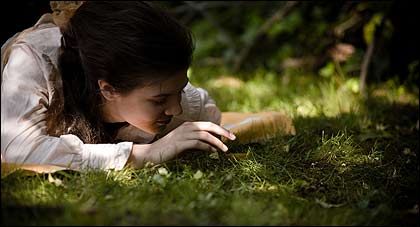
An Understanding Heart
Opal Whiteley returns to Oregon
By Camilla Mortensen
OPAL: A MOVIE: Directed by Dina Ciraulo. Screenplay by Dina Ciraulo, based on the story of Opal Whiteley. Cinematography, Svetlana Cvetko. Editor, Greg Sirota. Music, Terri Winston. Starring Nayeli Adorador-Knudsen, Roxanne Eldred, George Maguire and Gabriel Marin. 2011. R. 1 hour, 20 minutes.. ![]()
 |
| Nayeli Adorador-Knudsen in Opal |
For some of us, interest in Opal Whiteley stems from the charm of her tales about rambles in the woods and farms around Cottage Grove and the unique phrases and names she used in her childhood diary. The first sentences of her diary capture some of the magic of her childish language: “I like it ã this house we do live in being at the edge of the near woods. So many little people do live in the near woods. I do have conversations with them. I found the near woods first day I did go explores.”
The diary reflects Whiteley’s lifelong fascination with the natural world. Whiteley’s “explores” took her from the woods to the house of “the girl who has no seeing” and visits to animal friends like the crow Lars Porsena of Clusium and the “singing brooks that come going to the riviúre.” The riviúre she writes of is believed to be Mosby Creek, and her use of French has been attributed to her claims of French lineage, and the fact that many French logging families were in the vicinity during her childhood in the early 1900s. Its also been used to substantiate accusations that her diary is a hoax.
So for others, interest in Opal Whiteley centers on the story of her life and the question of whether she wrote that diary as a child, as a hoax or as an adult with a possible mental illness. Some have speculated Whiteley was schizophrenic, others that she had Aspergers Syndrome. Many have mourned the fact that the genius that was Whiteley spent the last half of her life in an institution, writing no more books and giving no more lectures on the natural world.
Opal: A Movie focuses less on Whiteley’s childhood years and more on the saga of her life. Using old-fashioned acting with stilted phrasing and sepia-toned shots, director Dina Ciraulo chronicles Whiteley’s journey from the woods — unfortunately not shot in the unique old-growth forests of Oregon but in the redwoods of California due to financial constraints — to her time at the UO and all the way to Napsbury Hospital, a care facility in England where she was placed in 1948 when she was deemed unable to care for herself. She died there in 1992 at the age of 95 (the films credits mistakenly give the date as 1995).
For those familiar with the diary but less familiar with Whiteley’s life as a whole, the films chronicle of her career lecturing on nature, her time at the University of Oregon, her dealings with the Atlantic Monthly as it published her diary and the confusion of her later years will be intriguing. Opal bills itself as “inspired by a true story” but, for the most part, it stays close to historical accounts of her life. The Cottage Grove Sentinel becomes the Elk Grove Sentinel in the film, and names are changed, but the narrative takes few truly fictional liberties.
Opal is unabashedly an art film, seeking a period look and tone. Whiteley is played for most of the movie by Nayeli Adorador-Knudsen, who is somehow reminiscent of a dark-haired Drew Barrymore. For some, the actor’s somewhat affected and overly precious performance might grate.
It stays true to the storyline of Whiteley’s life, and neither attempts to confirm nor deny her claims that she was adopted by the Whiteley family and was actually the daughter of Frances Prince Henri dOrléans. Her tombstone in England bears the name she favored in her later years — Francoise Marie de Bourbon-Orleans — and the words “I spake as a child.”
Opal plays one night only at Bijou Cinemas, 7 pm Thursday, March 10. $8 adults, $5 seniors & students. The film will be followed by a question and answer session with writer/director Diane Ciraulo and two of the film’s producers.